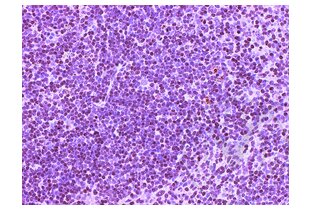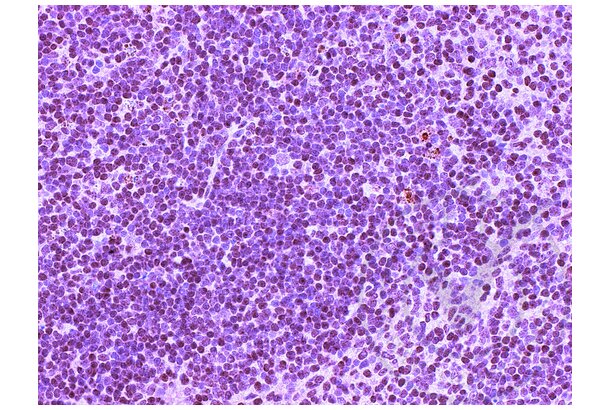Immunophenotyping
Categories
Immunophenotyping enables scientists and clinicians to distinguish different cell populations in a sample relying on immunolabeling of cell-type specific surface markers and intracellular protein markers. This antibody-based labeling is used in basic research and in diagnostic settings to identify diseases or disease progression. Immunophenotyping for instance serves to define specific types of cancer. It may also be applied to separate cells into different subpopulations based on markers on their cell surface. The varying composition of immune cell populations such as T-Cells, B-Cells, NK cells, or dendritic cells help to track the immune response in different diseases states or therapy effectiveness.
Immunophenotyping: Immune Cell Guide

Selected cell markers used for immunophenotyping.
Methods to Characterize Cells Populations Through Immunophenotyping
- Flow Cytometry allows the separation of single cells in solution depending on fluorescently labeled antibodies bound to the antigen of interest, typically on the cell surface. The labeled cells pass through a flow cytometer and those containing the respective label are separated from the other cells in the population. This allows simultaneous identification and quantification of different cell types. Flow cytometry can analyze large numbers of cells rapidly and provides detailed information about multiple markers simultaneously.
- Mass cytometry, or cytometry by time-of-flight (CyTOF) uses antibodies conjugated to lanthanide or other high-purity heavy-metals instead of fluorescent labels. Labeled cells are then analyzed in a mass cytometer, which measures the heavy-metal tags. Mass cytometry allows the simultaneous analysis of numerous markers.
- Immunohistochemistry is a commonly used immunophenotyping method that retains the tissue structure, in which cells of interest are embedded: antibody binding across intact tissue samples varies depending on the expression and distribution of specific cell markers. The bound antibodies are then visualized using enzymatic or fluorescent detection methods, allowing for the visualization and localization of specific cell types within the tissue.
- Immunofluorescence is a similar technique but is commonly applied to cultured cells or cells in suspension. It involves labeling cells with fluorescently labeled antibodies specific to the markers of interest.
These methods can be used in combination to provide insights into different cell populations in a biological sample to guide research and therapy.
The choice of cell markers for immunophenotyping may vary depending on the specific research context and experimental objectives. The combination of multiple markers can provide a more comprehensive characterization of the cell type in question and help distinguish them from other cell types.
Cell Markers for Immunophenotyping
antibodies-online offers high-quality cell markers for a variety of cell types suitable for immunophenotyping experiments. Discover important markers for immune cells, such as B-Cell or T-Cell Marker together with markers for different tissue types on the left.
Immunophenotyping: From Cancer Research to Disease Diagnostics
Immunophenotyping, a technique used to analyze and characterize immune cells based on their surface markers and other molecular features, has gained immense importance across various fields of research and clinical practice. Whether in immuno-oncology research, drug discovery, clinical trials, or disease diagnostics, the ability to comprehensively profile immune cell populations has revolutionized our understanding of immune responses and paved the way for innovative therapeutic strategies. Flow cytometry, a key technology in immunophenotyping, has enabled the simultaneous analysis of multiple parameters, providing researchers with rapid and cost-effective insights into immune cell behavior.
1. Immuno-Oncology Research
One of the most prominent areas where immunophenotyping has made significant strides is immuno-oncology research. This field focuses on understanding the intricate interplay between the immune system and cancer cells. Immune cells play a critical role in either tolerating or attacking cancer cells. The process of cancer immunity involves a cascade of events, from cancer cell-induced inflammation to the activation of various immune cell types.
In this context, immunophenotyping allows researchers to dissect the composition of immune infiltrates within tumors. Antigen-presenting cells like natural killer (NK) cells, dendritic cells, and macrophages respond to inflammation markers released by cancer cells, initiating a series of immune responses. Activated T cells, upon infiltrating the tumor, identify tumor-specific antigens and initiate the process of eliminating cancer cells. Immunophenotyping helps researchers understand the abundance, distribution, and activation status of these immune cell populations within the tumor microenvironment. This knowledge is crucial for developing immunotherapies that enhance the body's natural defenses against cancer.
2. Basic Drug Discovery Research
In the realm of drug discovery, immunophenotyping offers a unique opportunity to evaluate potential therapeutics. Researchers can use this technique to assess how drug candidates modulate immune cell responses. For instance, by analyzing the impact of a drug on T cell activation, proliferation, or cytokine secretion, researchers can gauge its potential for enhancing immune responses against infections or autoimmune diseases.
Additionally, immunophenotyping aids in identifying unintended effects of drugs on immune cells. Some drugs might inadvertently suppress immune function, leading to increased susceptibility to infections. By carefully studying immune cell populations, researchers can identify any negative impacts on the immune system early in the drug development process.
3. Clinical Studies and Disease Diagnostics
Advanced-stage clinical studies benefit significantly from immunophenotyping. For instance, in clinical trials evaluating the effectiveness of immunotherapies, monitoring changes in immune cell populations over time can provide insights into treatment efficacy. Such longitudinal analysis helps clinicians adapt treatment strategies for better patient outcomes.
Immunophenotyping also plays a crucial role in disease diagnostics. In conditions where immune dysfunction is a hallmark, such as autoimmune diseases or immunodeficiencies, profiling immune cells can aid in accurate diagnosis and monitoring of disease progression. By identifying specific immune cell abnormalities, clinicians can tailor treatment plans to target the underlying immunological issues.
Conclusion
Immunophenotyping has transcended traditional boundaries, impacting diverse areas of research and clinical practice. Its applications in immuno-oncology research, drug discovery, clinical studies, and disease diagnostics have unveiled new avenues for therapeutic intervention and a deeper understanding of immune responses. The integration of flow cytometry and other advanced technologies has empowered researchers and clinicians to unravel the complexities of immune cell populations, paving the way for more personalized and effective treatments across a spectrum of diseases. As technology continues to evolve, the future of immunophenotyping holds even more promise in shaping the landscape of medicine and biology.
Selected Immunophenotyping Antibodies for Flow Cytometry

 CD4 antibody (AA 385-457) (ABIN671376)
CD4 antibody (AA 385-457) (ABIN671376)
- Quality CD4 Antibody
- For Immunophenotyping
- Validated for FACS
- In stock, fast delivery
References
- : "Standardizing immunophenotyping for the Human Immunology Project." in: Nature reviews. Immunology, Vol. 12, Issue 3, pp. 191-200, (2012) (PubMed).
- : "CellMarker: a manually curated resource of cell markers in human and mouse." in: Nucleic acids research, Vol. 47, Issue D1, pp. D721-D728, (2020) (PubMed).
- : "Advanced immunophenotyping: A powerful tool for immune profiling, drug screening, and a personalized treatment approach." in: Frontiers in immunology, Vol. 14, pp. 1096096, (2023) (PubMed).

Goal-oriented, time line driven scientist, proficiently trained in different academic institutions in Germany, France and the USA. Experienced in the life sciences e-commerce environment with a focus on product development and customer relation management.
Go to author page



